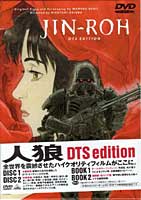by Luis Reyes
|
Inspired by the surging popularity of anime, aided in part by more companies licensing and distributing titles in the US and the inclusion of anime in highly visible outlets such as the Cartoon Network, several new feature projects will grace screens in 2001. And all of these will adhere to a far more modest marketing strategy than the larger Hollywood studios. ADV's "Spriggan," which will open this fall, promises to do well with a production team including producer Katsuhiro Otomo and director Hirotsugu Kawasaki ("Akira," "Memories") and character designer Hisachi Eguchi (Perfect Blue). So far the action thriller about the search for Noah's Ark has been touring film festivals, including the New York Film Festival and the American Film Institute Festival in Los Angeles, where it was one of only two animated films included. "'Spriggan' is much better fit for American audiences because the elements of 'Spriggan' closely fit with a typical American action flick," explains ADV vice-president Matt Greenfield in an interview with Fantasticon. ADV has also brought on Carl Macek, the man responsible for bringing "Robotech" to the American market in the '80s, to aid further attempts to put more anime on the big screen.
Manga Entertainment is currently looking forward to the release of Production I.G's "Blood: The Last Vampire." "We are very excited about the release of 'Blood,' Egan says. "Manga Entertainment continues to look for the best available films in Japan to bring to US audiences." And Urban Vision anticipates a highly successful run of their new "Vampire Hunter D," a new chapter of the 1980s anime classic from Madhouse. Tentatively scheduled for summer/fall of 2001, "D's" positive feedback has encouraged a far-reaching marketing campaign. However, the litmus test of anime's popularity with the non-family American mainstream could very well be Bandai Entertainment's release of Production I.G's "Jin-Roh," a dark, moody tale about police corruption and the psychology of death. This film has garnered acclaim at both Cannes and the Berlin Film Festival and impressive reviews from a wealth of mainstream media, focused primarily on anime legend Mamoru Oshii's script and director Hiroyuki Okiura. "Variety's" Derek Elley writes, "Okiura's take as director of Oshii's script plays up the beauty-and-the-beast side, achieving some nice moments of stillness and childlike beauty and peace in between the dark, violent action sequences." "Jin-Roh" will premiere at California State University, Long Beach's Animation Film Festival in late May and then run in limited release in New York and Los Angeles in June. Unlike "Spriggan," "Jin-Roh" doesn't adhere closely to the conventions of an American action film. But like "Laputa," "Jin-Roh's" ending raises more questions than it answers.
Perhaps trying to stretch these anime features' niche appeal into the mainstream market is a futile endeavor. The most candid assessment of anime's big screen success in America comes from "Utena" director Kunihiko Ikuhara. "For animation to succeed in the US it has to be made in the US," Ikuhara says. "There's a cultural barrier. Japanese people want to spread their animation in the US, but American companies just want to use Japanese talent." Nevertheless, need for a wide variety of animation has expanded the scope of the animated feature market. "I actually think the appetite for traditional animation is greater these days. What's happened, though, is that animated movies have become more numerous, so people have become more discriminating and discerning about what they like," said Ann Daly, president of animation for Dreamworks, in a "New York Times" article this past July. If animation, then, can be marketed more like art house films - not automatically to the kids demographic, but to an identifiable niche - then anime, which encompasses a wide spectrum of genres, may fill that niche. |
||||||
|
The Road to El Dorado © Unviversal / Dreamworks.
Titan AE © Fox Entertainment.
Princess Mononoke © NIBARIKI-TNDG / Buena Vista Home Entertainment Inc.
Blue Submarine No. 6 © Satoru Ozawa / Bandai Visual / Toshiba EMI / Gonzo / Bandai Ent.
Ghost in the Shell © Masamune Shirow / Kodansha Ltd/Bandai Visual Ltd / Manga Entertainment Inc.
Jin-Roh © Mamoru Oshii / Bandai Visual / Production I.G.
|


